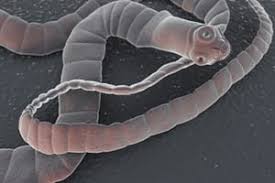Including raw fish used to make sushi, especially if it is not frozen at sea.
Following up my chat with daughter Sorenne while strolling around Noumea, New Caledonia last week, a Fresno man with a daily sushi habit had a 5.5-foot tapeworm lodged in his intestines. He pulled it out himself, wrapped it around a cardboard toilet paper tube and carried the creature into Fresno’s Community Regional Medical Center.
Michelle Robertson, a San Francisco Gate staff writer, reports that Kenny Banh was the lucky doc on shift at the time. He recounted his experience on a recent episode of the podcast “This Won’t Hurt A Bit.”
Banh said the patient complained of “bloody diarrhea” and expressed a desire to get treated for tapeworms.
“I get asked this a lot,” the doctor said. “Truthfully, a lot of times I don’t think they have it.”
This man had it, which he proved to Banh by opening a plastic grocery bag and pulling out the worm-wrapped toilet paper tube.
Banh then asked some questions, starting with: “That came out of your bottom?”
“Yes.”
According to the doctor’s retelling, the patient was using the restroom when he noticed what looked like a piece of intestine hanging out of his body.
“He grabs it, and he pulls on it, and it keeps coming out,” Banh recounted. He then picks the thing up, “looks at it, and what does it do? It starts moving.”
That’s when the man realized he had a tapeworm stuck in his insides. He headed to the emergency room shortly thereafter, where Banh treated him with an anthelmintic, a single-treatment deworming medication used on humans and dogs alike.
Banh also took it upon himself to measure the specimen on the floor of the hospital. It stretched a whopping 5 feet, 6 inches — “my height,” noted the doctor.
Tapeworms can be contracted in a variety of ways, but Banh said his patient hadn’t traveled out of the country or engaged in any out-of-the-ordinary behavior. The man also professed his love of sushi, specifically raw salmon sashimi, which he confessed to eating daily.
Fresno is located an ample 150 miles from coastline and is not exactly famed for its sushi. The Centers for Disease Control and Prevention warned last February that the rise in popularity of raw fish consumption has likely spurred
 The story has attracted attention all over the world, as these things tend to do, says Peter Olson, a tapeworm expert and a researcher at the Natural History Museum’s life sciences department, who was quoted as telling The Guardian, “because they’re gross”. The worm, he says, was “almost certainly something called the broad fish tapeworm … salmon is one of the main ways you would pick it up, if you don’t cook the meat.” The life of the broad fish tapeworm involves more than one host. “A typical life cycle might include a bear that feeds on salmon, then defecates back into the river. The larvae would be passed into the environment and, in the case of an aquatic life cycle like this, it would be eaten by something like a copepod, a little crustacean. When that copepod is eaten by a fish, it would transform into a larval tapeworm and that’s what is being transmitted to a human in this case. That would go to the intestine and grow into this giant worm.”
The story has attracted attention all over the world, as these things tend to do, says Peter Olson, a tapeworm expert and a researcher at the Natural History Museum’s life sciences department, who was quoted as telling The Guardian, “because they’re gross”. The worm, he says, was “almost certainly something called the broad fish tapeworm … salmon is one of the main ways you would pick it up, if you don’t cook the meat.” The life of the broad fish tapeworm involves more than one host. “A typical life cycle might include a bear that feeds on salmon, then defecates back into the river. The larvae would be passed into the environment and, in the case of an aquatic life cycle like this, it would be eaten by something like a copepod, a little crustacean. When that copepod is eaten by a fish, it would transform into a larval tapeworm and that’s what is being transmitted to a human in this case. That would go to the intestine and grow into this giant worm.”
(On one of our first dates, over 12 years ago – same age as barfblog.com — Amy tried to serve me grilled salmon. I whipped out my trusty tip-sensitive digital thermometer and noted a 98F reading, and said, no way. Cook it.)
The tapeworm is a monstrous and impressive creation. It has a segmented body, with male and female reproductive organs in each segment, so it is capable of self-fertilisation. It does not have a head as such – its “head” is only useful for holding on to its host’s gut, rather than for “eating” (it absorbs nutrients through its skin). In many cases, you would not know you were infected. You might spot bits of tapeworm segment in your stool – small, pale, rice-like bits – or experience stomach pain or vomiting.


